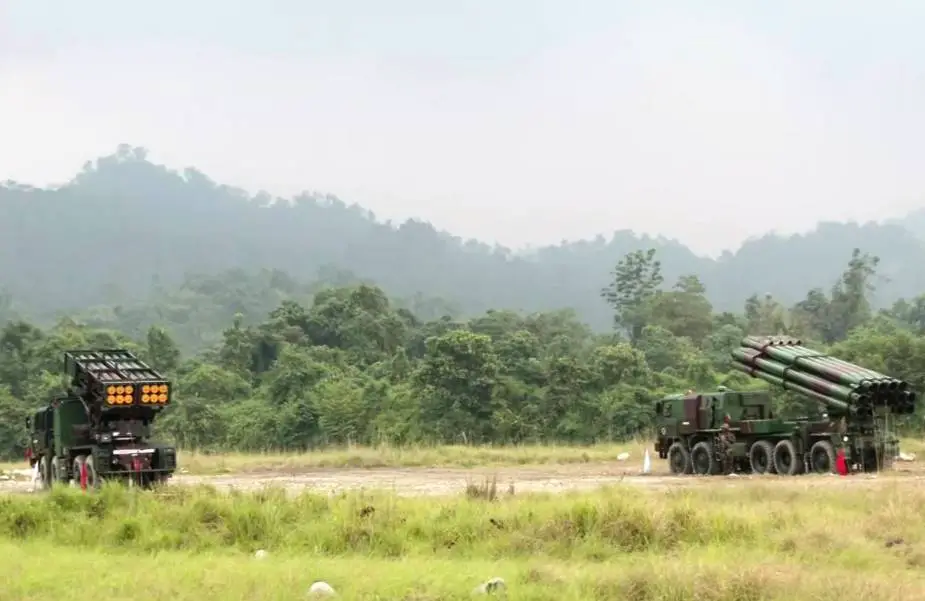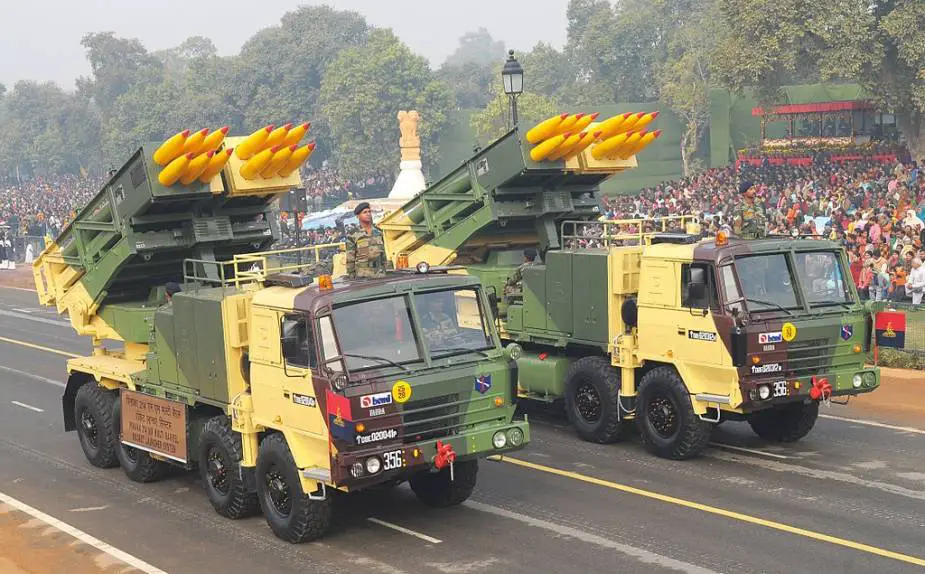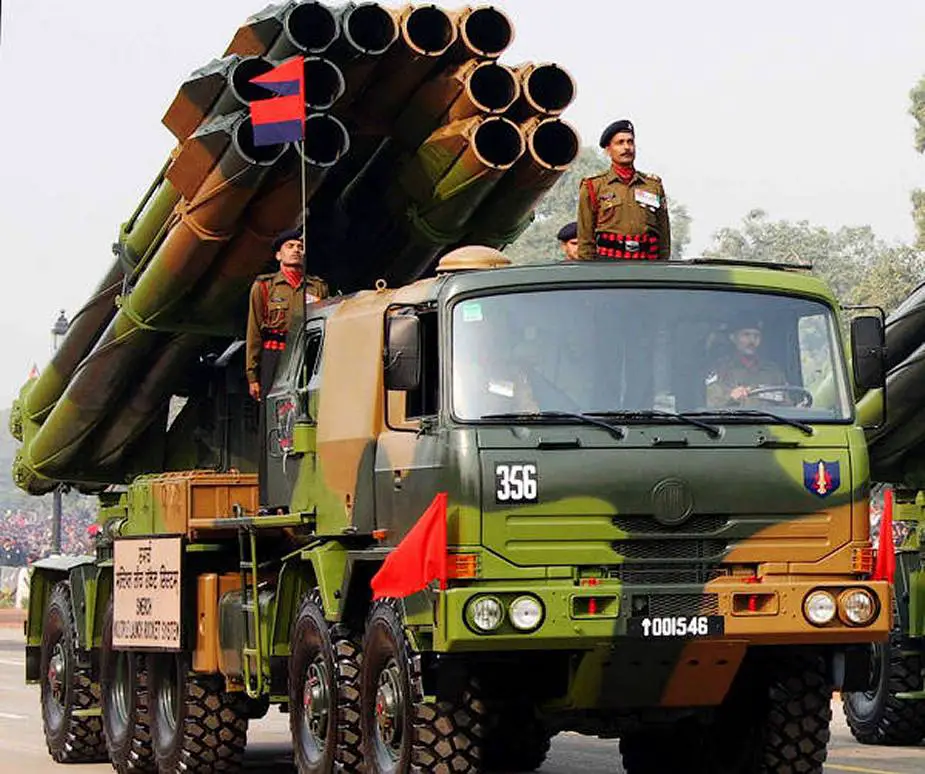As reported by The Times of India, the Indian Army has deployed Pinaka and Smerch Multiple Rocket Launcher Systems (MRLS) at forward positions near the China border to counter any threat arising across on the Line of Actual Control (LAC).
Follow Army Recognition on Google News at this link

The Indian Army has deployed Pinaka and Smerch Multiple Rocket Launcher Systems (MRLS) at forward positions near the China border (Picture source: ANI)
Pinaka is a multiple rocket launcher produced in India and developed by the Defence Research and Development Organisation (DRDO) for the Indian Army. The system has a maximum range of 40 km for Mark-I and 60 km for the Mark-I enhanced version and can fire a salvo of 12 HE rockets in 44 seconds. The system is mounted on a Tatra truck for mobility. Pinaka saw service during the Kargil War, where it was successful in neutralizing enemy positions on the mountain tops. It has since been inducted into the Indian Army in large numbers. About 5,000 missiles are being produced every year while an advanced variant is under development with enhanced range and accuracy. In 2019, an upgraded guided-missile version of the system had been test-fired, with a range of over 90 km.

Pinaka Multiple Rocket Launcher Systems (MRLS) of the Indian army (Picture: Indian MoD)
The BM-30 Smerch (Tornado, whirlwind), 9K58 Smerch or 9A52-2 Smerch-M is a Soviet-era heavy multiple rocket launcher. The system was designed in the early 1980s and entered service in the Soviet Army in 1989. When first observed by the West in 1983, it received the code MRL 280mm M1983. In India, a total of 162 9A52-2T systems are in service. The launchers for the Indian Army’s 9K58 Smerch 300 mm multiple rocket launch (MRL) systems are mounted on 81 Indian designed 10×10 high-mobility vehicles provided by Indian private-sector defense manufacturer Ashok Leyland. The vehicle, which is fitted with a hydraulic crane to reload the system, will supplement and eventually replace the 9A52-2 launch vehicles based on the MAZ-543M 8×8 truck chassis. The Indian Army operates several launcher variants for the Smerch system, including around 162 9K58 Smerch batteries, each of which has six launch vehicles. Since 2012 India’s state-owned Ordnance Factory Board has produced several rocket variants for the system that have a strike range of 70 or 90 km."

Smerch Multiple Rocket Launcher Systems (MRLS) of the Indian army (Picture Indian: MoD)
Sino-Indian border conflict
Beginning on 5 May 2020, Chinese and Indian troops engaged in aggressive melee, face-offs and skirmishes at locations along the Sino-Indian border, including near the disputed Pangong Lake in Ladakh and the Tibet Autonomous Region, and near the border between Sikkim and the Tibet Autonomous Region. Additional clashes also took place at locations in eastern Ladakh along the Line of Actual Control (LAC).
In late May, Chinese forces objected to Indian road construction in the Galwan river valley. According to Indian sources, melee fighting on 15/16 June 2020 resulted in the deaths of 20 Indian soldiers and casualties of 43 Chinese soldiers. Media reports stated that soldiers were taken captive on both sides and released in the coming few days while official sources on both sides went on to deny this. On 7 September, for the first time in 45 years, shots were fired along the LAC, with both sides blaming each other for the firing. Indian media also reported that Indian troops fired warning shots at the PLA on 30 August.
Partial disengagement from Galwan, Hot Springs and Gogra occurred in June–July 2020 while complete disengagement from Pangong Lake north and south bank took place in February 2021. Following disengagement at Gogra in August 2021, Indian analysts pointed out that the LAC has shifted westwards at patrol point 17A (PP 17A).
Amid the standoff, India reinforced the region with approximately 12,000 additional workers, who would assist India's Border Roads Organisation in completing the development of Indian infrastructure along the Sino-Indian border. Experts have postulated that the standoffs are Chinese pre-emptive measures in responding to the Darbuk–Shyok–DBO Road infrastructure project in Ladakh. China has also extensively developed their infrastructure in these disputed border regions and are continuing to do so. The revocation of the special status of Jammu and Kashmir, in August 2019, by the Indian government has also troubled China. However, India and China have both maintained that there are enough bilateral mechanisms to resolve the situation. This includes multiple rounds of colonel, brigadier and major general rank dialogue, special representatives' meetings, meetings of the 'Working Mechanism for Consultation and Coordination on China-India Border Affairs' (WMCC), meetings and communication between the foreign ministers and the defense ministers. On 10 October 2021, the 13th corps-commander-level meeting took place. The Chinese and Indian armies keep reinforcing their units deployed in the area, though.
Following the Galwan Valley skirmish on 15 June, some Indian campaigns about boycotting Chinese products were started. Action on the economic front included cancellation and additional scrutiny of certain contracts with Chinese firms, and calls were also made to stop the entry of Chinese companies into strategic markets in India. By November 2020, the Indian government had banned over 200 Chinese apps including apps owned by Alibaba, Tencent, Baidu, Sina, and Bytedance.














